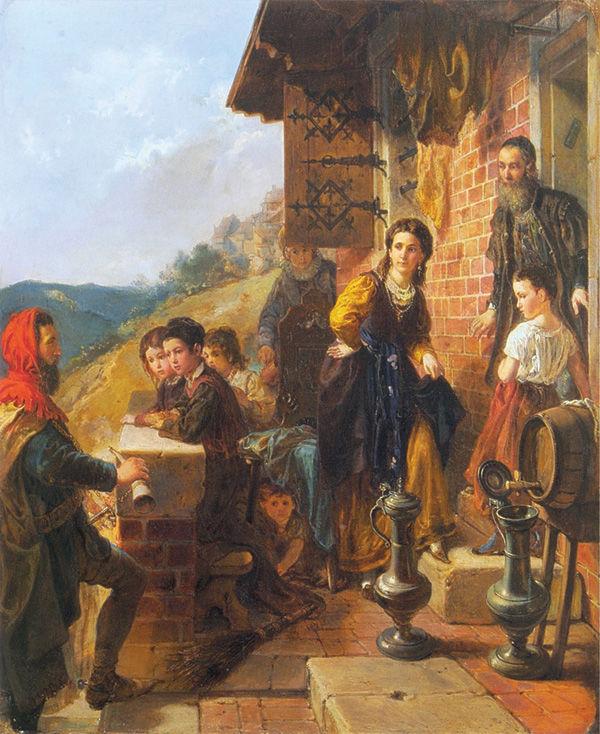Affairs of state: How Jewish mistresses played major roles in history
Published December 28, 2016
Zsa Zsa Gabor, the Jewish-born actress and femme fatale who died Dec. 18 at the age of 99, collected nine husbands and countless lovers during her long life. “I am a marvelous housekeeper. Every time I leave a man, I keep his house,” Gabor famously quipped.
Gabor was born Sari Gabor in 1917 in Budapest, Hungary, the middle of three daughters. Both of her parents, Vilmos, a soldier, and Jolie (née Janka Tilleman), were Jewish. Like fellow celebrities Elizabeth Taylor and Marilyn Monroe, both Jews by choice, Gabor made no apologies for weaponizing her beauty, along with a devilish sense of humor, to seduce numerous lovers.
Of course Gabor, Taylor and Monroe were not alone among Jewish women who exploited their beauty and seductiveness to attract and sometimes marry famous men. Over the centuries, numerous Jewish women have had romantic or erotic relationships with the rich and powerful. In some cases, these women would use their influence over their paramours to defend or protect fellow Jews.
Here are a few notable examples of some of history’s most notorious Jewish mistresses and the influence they had over world rulers:
• Esterka of Opoczno, the favorite mistress of King Casimir III the Great of Poland (1310-1370), with whom he had two daughters. According to historic accounts and legend, Esterka was instrumental in persuading Casimir to offer rights to the Jews of Poland for an extended period. The house in Krakow in which Casimir and Esterka had their liaisons is a respected site among the Jews of Poland.
Among Polish Jews, Esterka is often likened to Queen Esther, wife of King Ahasuerus (Xerxes), who intervened to foil the plot of the evil Grand Vizier Haman to kill the Jews of ancient Persia.
• Margherita Sarfatti, the mistress of Benito Mussolini. The Italian dictator seized power in Italy in 1922 as the leader of the Fascist Party, whose autocratic structure inspired the National Socialist Party of Germany. According to an article by Mandy Katz in the July 2007 edition of Moment magazine, Sarfatti, the brilliant and beautiful granddaughter of a former mayor of Venice, met Mussolini during his days as a socialist and editor of the Socialist Party organ Avanti, of which Mussolini became editor.
Sarfatti was the art critic for the publication during Mussolini’s tenure as Avanti editor.
“The comely and fiercely intelligent Sarfatti, from a wealthy Venetian family, served as his mistress as well as a trusted political adviser who helped pave her lover’s way to power,” Katz writes.
It may come as a surprise to some that Mussolini, who founded Italy’s National Fascist Party and later became Hitler’s partner in the Pact of Steel between the Axis powers, started out as a socialist who initially rejected Hitler’s anti-Semitism as “scientific nonsense.”
Later, when Mussolini agreed, under pressure from Hitler, to adopt anti-Semitic “racial laws,” his relationship with Sarfatti became unsustainable. According to some accounts, Sarfatti told Mussolini she should could no longer serve as his mistress because he had betrayed her fellow Jews.
• Magda (Elena) Lupescu (1895-1977) was among the most famousand consequential of the Jewish mistresses of powerful men. Lupescu was the mistress of King Carol II of Romania and became his wife several years after his abdication. Daughter of Elise and Nicolae Lupescu, both of her parents were reportedly Jewish although she was raised Catholic.
While she was still married to Ion Tâmpeanu, a Romanian Army officer, she met the Crown Prince (later King Carol II), who was immediately smitten by her appearance and personality.
King Carol’s grandson Lupescu recalled Lupescu as “a witty and outspoken woman; a tall, perhaps fleshy, redhead with milky white skin and green eyes.”
Other descriptions are less flattering. Without getting bogged down in the details of their scandalous affair, she was even the target of a ribald limerick that mocked her Jewishness and ties to King Carol and invoked the fierce anti-Semitism that fueled much of the criticism of the relationship.
Carol engineered a coup, which empowered him to become King of Romania. Eventually, he was forced toabdicate because of rampant corruption and intrigue in Romania and the rise of fascism.
Carol and Lupescu lived in Mexico, Brazil and eventually in Portugal before he died in 1953; Lupescu survived him by 24 years. They were reunited in death when their coffins were reburied side by side.
• Poppaea Sabina may have been one of the most ancient Jewish mistresses, in this case to Roman Emperor Nero, later becoming his second wife about 62 C.E. In her Moment magazine story, Katz writes that Sabina was not truly Jewish: She belonged to a Judaistic cult known as “God-fearers,” a movement whose members recognized and worshipped the Jewish God and were permitted to mingle with synagogue worshippers.
Though she never converted, she did urge Nero to intervene on behalf of a group of Jewish priests imprisoned in Jerusalem, and he did. Nero, according to Katz, continued to persecute Jews during the rest of his brutal reign.
There are numerous other examples of Jewish lovers or objectsof affection for powerful men, including the semilegendary Solica of Morocco, who was beheaded when she refused to convert to Islam in order to marry the son of the Sultan. Today she is revered by both Jews and Muslims in Morocco as a symbol of fortitude and bravery.
So what are we to make of the fact that there were, throughout history, Jewish women who had affairs with powerful men — and sometimes used their relationships to help their fellow Jews? It proves that after all, Jews are people like all of humankind. The fact that some of these women intervened on behalf of their own people makes up a reassuring series of footnotes to this curious aspect of Jewish history.















